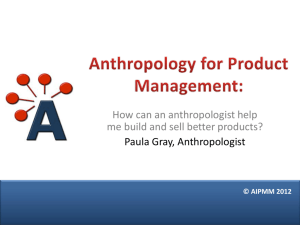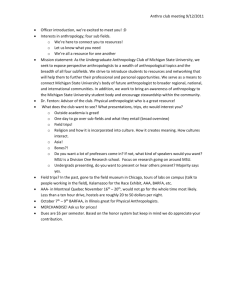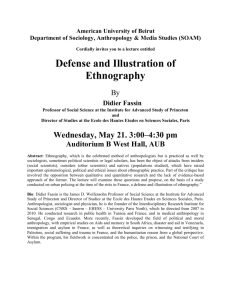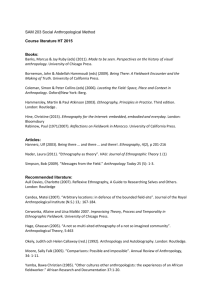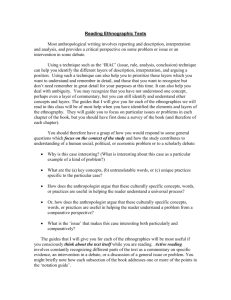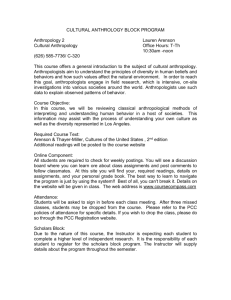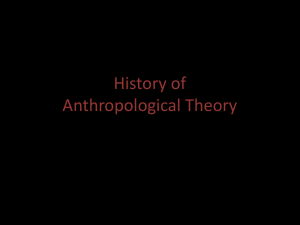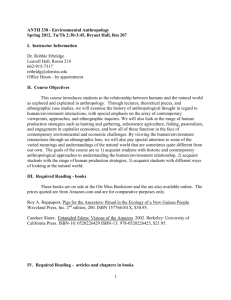Cultural Anthropology Exam 1
advertisement
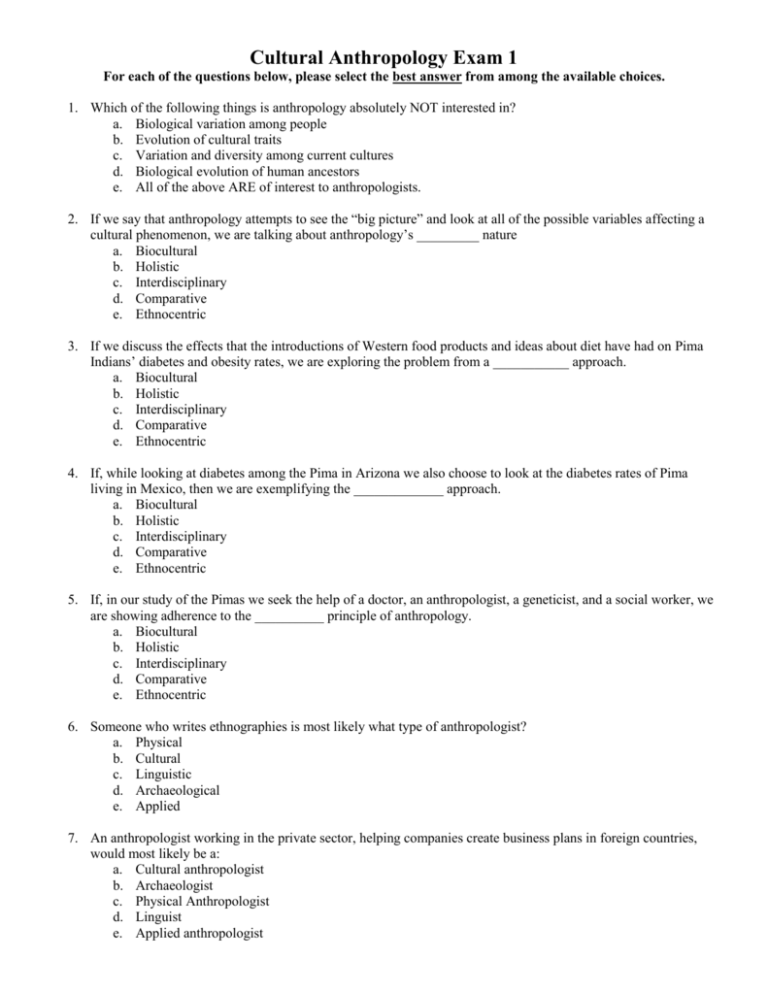
Cultural Anthropology Exam 1 For each of the questions below, please select the best answer from among the available choices. 1. Which of the following things is anthropology absolutely NOT interested in? a. Biological variation among people b. Evolution of cultural traits c. Variation and diversity among current cultures d. Biological evolution of human ancestors e. All of the above ARE of interest to anthropologists. 2. If we say that anthropology attempts to see the “big picture” and look at all of the possible variables affecting a cultural phenomenon, we are talking about anthropology’s _________ nature a. Biocultural b. Holistic c. Interdisciplinary d. Comparative e. Ethnocentric 3. If we discuss the effects that the introductions of Western food products and ideas about diet have had on Pima Indians’ diabetes and obesity rates, we are exploring the problem from a ___________ approach. a. Biocultural b. Holistic c. Interdisciplinary d. Comparative e. Ethnocentric 4. If, while looking at diabetes among the Pima in Arizona we also choose to look at the diabetes rates of Pima living in Mexico, then we are exemplifying the _____________ approach. a. Biocultural b. Holistic c. Interdisciplinary d. Comparative e. Ethnocentric 5. If, in our study of the Pimas we seek the help of a doctor, an anthropologist, a geneticist, and a social worker, we are showing adherence to the __________ principle of anthropology. a. Biocultural b. Holistic c. Interdisciplinary d. Comparative e. Ethnocentric 6. Someone who writes ethnographies is most likely what type of anthropologist? a. Physical b. Cultural c. Linguistic d. Archaeological e. Applied 7. An anthropologist working in the private sector, helping companies create business plans in foreign countries, would most likely be a: a. Cultural anthropologist b. Archaeologist c. Physical Anthropologist d. Linguist e. Applied anthropologist 8. A written description of the practices of a culture is called: a. Ethnology b. Ethology c. Ethnography d. Ethereality e. None of the above 9. The process of learning one’s own culture while growing up is called: a. Acculturation b. Enculturation c. Assimilation d. Relativism e. None of the above 10. Cultural relativity was a term first used by followers of Franz Boas in the early 20th century who believed that each culture needed to be studied in light of its own particular developments and differences. What theoretical orientation were Boas and his students using? a. Cultural ecology b. Unilineal evolution c. Interpretive anthropology d. Historical particularism e. Functionalism 11. As we discussed, a culture’s marriage patterns, living arrangements, social order, and subsistence are often intertwined with one another. To understand one aspect, we need to examine all of them. This is due to the __________ nature of all cultures. a. Integrated b. Symbolic c. Shared d. Learned e. Multidisciplinary 12. Peoples’ beliefs about the desirable goals for themselves and their society are referred to as: a. Norms b. World Views c. Values d. Symbols e. Roles 13. Which of the following would NOT be considered an element of cultural knowledge? a. Norms b. World Views c. Values d. Symbols e. All of the above ARE in fact considered parts of cultural knowledge 14. The way that people interpret themselves, people around them, reality at large, and their place in the world is a function of their: a. Norms b. World Views c. Values d. Symbols e. Integrity 2 15. The way people say members of a culture are expected to behave in a given situation is an expression of: a. Norms b. World Views c. Values d. Symbols e. Integrity 16. The idea that a person’s biological/genetic makeup directly affects the cultural behaviors he or she practices is: a. Cultural ecology b. Biological Determinism c. Ethnocentrism d. Cultural Relativity e. Displacement For the next five questions, choose from among the following responses: a. Phoneme b. Arbitrariness c. Displacement d. Discreteness e. Multimedia potential 17. 18. 19. 20. 21. The ability to speak about things not present in time or space. The separate units of sound in speech we combine with shared and conventional rules. The non-intuitive relationship between letters in the alphabet and their phonetic sounds. The smallest unit of sound with the ability to change meaning for speakers of a language. Ability to create meaningful messages with a variety of understandable means: writing, speaking, gesturing, etc. 22. The study of the ways in which people use language in various social situations is called: a. Phonics b. Phonemics c. Sociolinguistics d. Phonetics e. Proxemics 23. The study of the actual sounds produced by speakers of a language is called: a. Phonics b. Phonemics c. Sociolinguistics d. Phonetics/phonology e. Proxemics 24. The study of a speaker’s physical position relative to his audience would be part of: a. Phonics b. Phonemics c. Kinesics d. Phonetics e. Proxemics 25. The rules used in constructing meaning in language are called __________ while the entire vocabulary of a language is its__________. a. Syntax; Morpheme b. Dialect; Lexicon c. Tonality; Diction d. Grammar; Lexicon e. None of the above 3 26. A researcher who developed an idea about the effect of language on cultural perceptions about the world along with a colleague by the name of Benjamin Whorf was: a. Franz Boas b. Julian Steward c. Edward Sapir d. Bronislaw Malinowski e. None of the above 27. Which theoretical paradigm focused on how culture meets peoples’ biological, psychological, and social needs? a. Unilineal Evolution b. Functionalism c. Interpretive d. Postmodern e. None of the above 28. The earliest of the anthropological paradigms is: a. Historical particularism b. Cultural ecology c. Unilineal evolution d. Functionalism e. Postmodernism 29. The belief that culture is shaped to great extent by the environment in which a group of people finds itself is part of what theoretical orientation? a. Historical particularism b. Cultural ecology c. Unilineal evolution d. Functionalism e. Postmodernism 30. Cultural Materialists focus largely on: a. The psychological functions of cultural institutions b. Development of individuals’ personalities c. Cultural relativism d. Resource acquisition e. None of the above 31. The preferred term used to refer to an individual who shares cultural knowledge with a researcher is: a. Informant b. Culture Broker c. Headman d. Stoolie e. Consultant 32. Which of the following research techniques relies on interpretations of written accounts, usually taken by nonanthropologists? a. Ethnohistory b. Ethnology c. Ethnography d. Ethology e. Ethnicity 4 True/False Questions. Mark A for True and B for False. 33. _____ A researcher who utilizes documents rather than personal experience in the field to analyze a culture and create ethnography is called an applied anthropologist. 34. _____ From our discussions about the characteristics and nature of culture, it is possible for an individual to possess a culture unique and distinct from every other individual on the planet. 35. _____ Ethnohistory, ethnography, and ethnology are all three terms for the same thing; they are synonyms. 36. _____ The method of ethnographic research that involves living with and working among members of another culture is called participant observation. 37. _____ It has been shown that culture is, in fact, passed from one generation to another through genetic inheritance. 38. _____ Followers of the historical particularism or culture history school first introduced the idea of fieldwork as a necessity to understanding culture. 39. _____ Longitudinal studies attempt to study the same population over an extended period of time and thus are great for learning about long-term culture changes.. 40. _____ The concept of race is a scientifically valid one. 41. _____ Opponents of cultural materialism have stated that the concept of a “resource” is a cultural construction, not a part of empirical reality. 42. _____ The stereotypical/average personality attributable to members of a particular culture, which is based on the group’s particular norms, values, and so forth is called its modal personality. 43. _____ I believe that my belief system is better than that of everyone else in the world so I am being culturally relative. 44. _____ The earliest theory (from the 1850s) about cultural development was cultural ecology. 45. _____ It is reasonable to expect that, when presented with the same situation, members of different cultures will respond identically to it. This is an example of the universality of the human psyche. 46. _____ The definition, “culture is Man’s extrasomatic means of adaptation” refers to the idea that culture is not based in biological ability but upon cognitive (thinking) ability and provides a means of adapting to the environment beyond that which nature has provided us in our physical bodies. 47. _______Radcliffe-Brown said that cultures are like super-organic entities and the parts of the social system were there to ensure the survival of the culture, not the individual humans who were a part of it. 48. _____ A problem with unstructured interviews is the researcher may use his or her time inefficiently and collect much data irrelevant to a particular research interest. 49. _____ An advantage of structured interviews is the efficient use of time since many respondents may be covered quickly. 50. _____ As discussed in class, the stereotypical tendency of native Chinese speakers to interchange “flied lice” for “fried rice” was the result of a lack of phonemic differentiation of the /l/ and /r/ sounds in Chinese. 5


